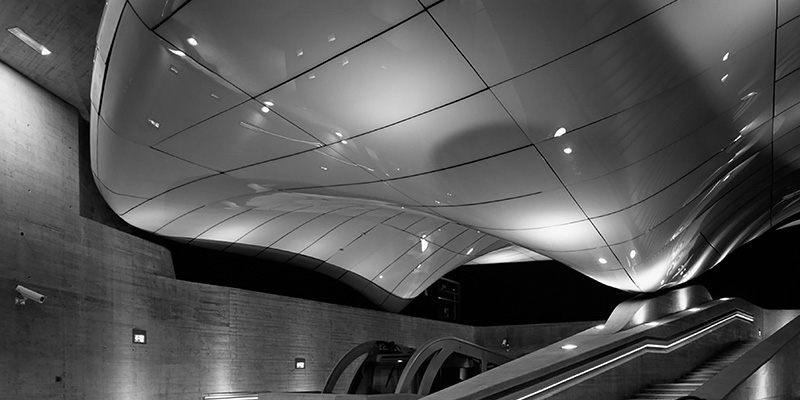Downloads
DOI:
https://doi.org/10.7480/jfde.2015.1.914Keywords:
Free-form architecture, double curvature facade panel, digital manufacturing, no-mould processes, CNC processesAbstract
Free-form architecture is one of the major challenges for architects, engineers, and the building industry. This is due to the inherent difficulty of manufacturing double curvature facades at reasonable prices and quality. This paper discusses the possibilities of manufacturing free-form facade panels for architectural envelopes supported by recent advances in CAD/CAM systems and digital processes. These methods allow for no-mould processes, thus reducing the final price. Examples of actual constructions will be presented to prove the viability of computer numerically controlled (CNC) fabrication technologies. Scientific literature will be reviewed. Promising fabrication methods (additive, subtractive, forming) to accomplish this proposal will be discussed. This research will provide valuable information regarding the feasibility of manufacturing free-form panels for architectural envelopes at lower prices.
How to Cite
Published
Issue
Section
License
Copyright (c) 2015 E. Castaneda, B. Lauret, J.M. Lirola, G. Ovando

This work is licensed under a Creative Commons Attribution 4.0 International License.
Authors or their institutions retain copyright to their publications without restrictions.
References
Alonso Pastor, L., Bedoya C., Lauret Aguirregabiria, B., & Alonso, F. (2013). F2TE3: Sistema de cerramiento transparente, ligero, de altas prestaciones energéticas que permite el diseño con formas libres. Informes De La Construcción, 65 (532), 443-456. doi: 0.3989/ic.12.068
Alonso Pastor, L., Lauret Aguirregabiria, B., Castañeda Vergara, E., Domínguez García, D., & Ovando Vacarezza, G. (2014). Free-form architectural facade panels: An overview of available mass-production methods for free-form external envelopes. 2nd International Conference on Construction and Building Research . Escuela Técnica de Ingeniería de Edificación Universitat Politècnica de València. 149-156. doi: 10.1007/978-94-007-7790-3_20
Buswell, R. A., Soar, R. C., Gibb, A. G. F., & Thorpe, A. (2007). Freeform construction: Mega-scale rapid manufacturing for construction. Automation in Construction, 16 (2), 224-231. doi: http://dx.doi.org/10.1016/j.autcon.2006.05.002
Buswell, R. A., Soar, R. C., Pendlebury, M., Gibb, A., Edum-Fotwe, F., & Thorpe, A. (2005). Investigation of the potential for applying freeform processes to construction. 3rd International Conference on Innovation in Architecture, Engineering and Construction (AEC), Rotterdam, Netherlands. 141-150.
Buswell, R. A., Thorpe, A., Soar, R. C., & Gibb, A. G. F. (2008). Design, data and process issues for mega-scale rapid manufacturing machines used for construction. Automation in Construction, 17, 923. doi: 10.1016/j.autcon.2008.03.001
Hauschild, M., & Karzel, R. (2011), Digital processes. Planning, design, production. Detail, Practice, Birkhäuser.
Hopkinson, N., & Dickens, P. (2003). Analysis of rapid manufacturing using layer manufacturing processes for production. Proceedings of the Institution of Mechanical Engineers. Part C: Journal of Mechanical Engineering Science, Special Issue on Rapid Manufacturing, 217 (1), 31-40.
Knaack, U., Bilow, M., & Strauss, H. (2008). Rapids. Layered fabrication technologies for facades and building construction . Rotterdam: 010 Publishers.
Kolarevic, B. (2003), Architecture in the digital age. design and manufacturing. New York: Taylor & Francis Group.
Kolarevic, B. (2005). Digital praxis: From digital to material. Proceedings of the 3rd Conference on “Innovation in Architecture, Engineering and Construction” , Delft University of Technology, Faculty of Architecture, Rotterdam, NL. , 1, 5-18.
Lee, G., & Kim, S. (2012). Case study of mass customization of double-curved metal façade panels using a new hybrid sheet metal processing technique. Journal of Construction Engineering and Management, 138, 1322-1330. doi: http://dx.doi.org/10.1061/(ASCE)CO.1943-7862.0000551
Naboni, Roberto; Paoletti, Ingrid (2015) , Advanced Customization in Architectural Design and Construction, PoliMi SpringerBriefs, doi: 10.1007/978-3-319-04423-1
Pegna, J. (1997). Exploratory investigation of solid freeform construction. Automation in Construction, 5 (5), 427-437. doi: 10.1016/S0926-5805(96)00166-5
Pronk, A., van Rooy, I., & Schinkel, P. (2009, January). Double-curved surfaces using a membrane mould. In Symposium of the International Association for Shell and Spatial Structures (50th. 2009. Valencia). Evolution and Trends in Design, Analysis and Construction of Shell and Spatial Structures: Proceedings. Editorial Universitat Politècnica de ValènciaDouble-curved surfaces using a membrane mould. Proceedings of the International Association for Shell and Spatial Structures (IASS) Symposium 2009, Valencia. Evolution and Trends in Design, Analysis and Construction of Shell and Spatial Structures, Valencia. pp. 618-628.
Strauß, H., (2013). AM envelope. The potential of additive manufacturing for façade construction. Delft: Architecture and the Built environment.
Ver Bruggen, Sara (2014, May 21). Chinese company prints 10 homes in one day, from http://www.forumforthefuture.org/greenfutures/articles/chinese-company-prints-10-homes-one-day
